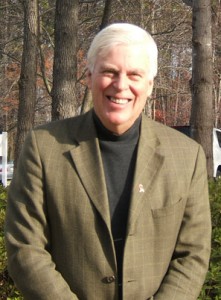Stephen J. O’Brien is First NSU Research Scientist to Receive Prestigious Honor
FOR IMMEDIATE RELEASE
FORT LAUDERDALE/DAVIE, Fla. – Research scientist Stephen J. O’Brien, Ph.D. has accomplished something no one else has done in the more than 50-year history of Nova Southeastern University (NSU) – he’s the first to be elected as a member of the National Academy of Sciences.
“It’s a special honor to be recognized by my peers and colleagues,” said O’Brien, who is a professor in NSU’s Halmos College of Natural Sciences and Oceanography. “The call from my dear friends who shepherded the nomination was both surprising and much appreciated. My career achievements were never solo, rather they stand on the shoulders of my many students, fellows and colleagues who took me along in their amazing science discoveries – for these I am humbled and grateful.”
According to the NAS: The National Academy of Sciences (NAS) is a private, non-profit society of distinguished scholars. Established by an Act of Congress, signed by President Abraham Lincoln in 1863, the NAS is charged with providing independent, objective advice to the nation on matters related to science and technology. Scientists are elected by their peers to membership in the NAS for outstanding contributions to research.
When it comes to research, O’Brien is well known among his peers. His career spans several decades, going back to a 25-year tenure as the Chief of the Laboratory of Genomic Diversity at the National Cancer Institute (NCI), National Institutes of Health (NIH) from 1986-2011. He joined the Theodosius Dobzhansky Center for Genome Bioinformatics in St. Petersburg State University (Russia) in December 2011, where he serves as its Chief Scientific Officer. In 2012, he joined the NSU Halmos College of Natural Sciences and Oceanography faculty as a professor.
His research interests and expertise span human and comparative genomics, genetic epidemiology, HIV/AIDS, retro-virology, bioinformatics biodiversity and species conservation. Some of his most well-known work involved genetic research into endangered wildlife species, including: African cheetahs, lions, Asian tigers and giant pandas, humpback whales and most recently, the white and black rhinoceros.
This latest research involved Dr. O’Brien working with colleagues across the globe to create a DNA database of rhinoceros, which is being used to help prosecute poachers. You could call it CSI meets conservation.
The African black and white rhinos are classified as critically endangered and near threatened, respectively. Their continued survival is jeopardized by habitat loss and a surge in illegal hunting for their horns that are considered of both medicinal value and as a cultural status symbol in Asian countries, mainly Vietnam and China. More than 7,000 rhinoceros have been killed through poaching in the past decade across Africa with South Africa suffering the highest losses.
The team developed an extensive database of rhinoceros DNA profiles and demographic information named RhODIS® (Rhino DNA Index System), modeled after CODIS, which is the U.S. FBI’s criminal DNA database. The RhODIS® forensic system involved African wildlife ranger training and certification, a chain of custody compliant sampling methodology used for live and dead rhinoceros and rhinoceros horns, an RhODIS™ field data collection “app” and state-of-the-art DNA genetic individualization. To date, more than 20,000 individual rhinoceros specimens and genotypes have been added to the RhODIS® database.
“We’ve seen a huge surge in the number of rhinos poached over the past couple of years simply because the financial reward far outweighed the risk,” Dr. O’Brien said. “Now that we can genetically tie someone to a specific cases of poaching, the chances of successful prosecution will go up – hopefully the risk will now not be worth it.”
Be sure to sign up for NSU’s RSS feed so you don’t miss any of our news releases, guest editorials and other announcements. Please sign up HERE.
###
About Nova Southeastern University (NSU): Located in beautiful Fort Lauderdale, Florida, NSU is ranked among U.S. News & World Report’s Top 200 National Research Universities and is a dynamic, private research university providing high-quality educational and research programs at the undergraduate, graduate, and first-professional degree levels. Established in 1964, NSU now includes 16 colleges, the 215,000-square-foot Center for Collaborative Research, a private JK-12 grade school, the Mailman Segal Center for Human Development with specialists in Autism, the world-class NSU Art Museum Fort Lauderdale, and the Alvin Sherman Library, Research and Information Technology Center, which is Florida’s largest public library. NSU has campuses in Fort Lauderdale, Fort Myers, Jacksonville, Miami, Miramar, Orlando, Palm Beach, and Tampa, Florida, as well as San Juan, Puerto Rico, while maintaining a presence online globally. Classified as a research university with “high research activity” by the Carnegie Foundation for the Advancement of Teaching, NSU is one of only 50 universities nationwide to also be awarded Carnegie’s Community Engagement Classification, and is also the largest private institution in the United States that meets the U.S. Department of Education’s criteria as a Hispanic-serving Institution. Please visit www.nova.edu for more information about NSU.
About NSU’s Halmos College of Natural Sciences and Oceanography: The college provides high-quality undergraduate (bachelor’s degree) and graduate (master’s and doctoral degrees and certificates) education programs in a broad range of disciplines, including marine sciences, mathematics, biophysics, and chemistry. Researchers carry out innovative basic and applied research programs in coral reef biology, ecology, and geology; fish biology, ecology, and conservation; shark and billfish ecology; fisheries science; deep-sea organismal biology and ecology; invertebrate and vertebrate genomics, genetics, molecular ecology, and evolution; microbiology; biodiversity; observation and modeling of large-scale ocean circulation, coastal dynamics, and ocean atmosphere coupling; benthic habitat mapping; biodiversity; histology; and calcification. The college’s newest building is the state-of-the-art Guy Harvey Oceanographic Center, an 86,000-square-foot structure filled with laboratories; offices; seminar rooms; an auditorium; and indoor and outdoor running sea water facilities. Please visit cnso.nova.edu for more information.
MEDIA CONTACT
May 7, 2018
Joe Donzelli | Office of Media Relations
954-262-2159 (office) | 954-661-4571 (cell)
jdonzelli@nova.edu | www.nova.edu | @NSU_Joe
